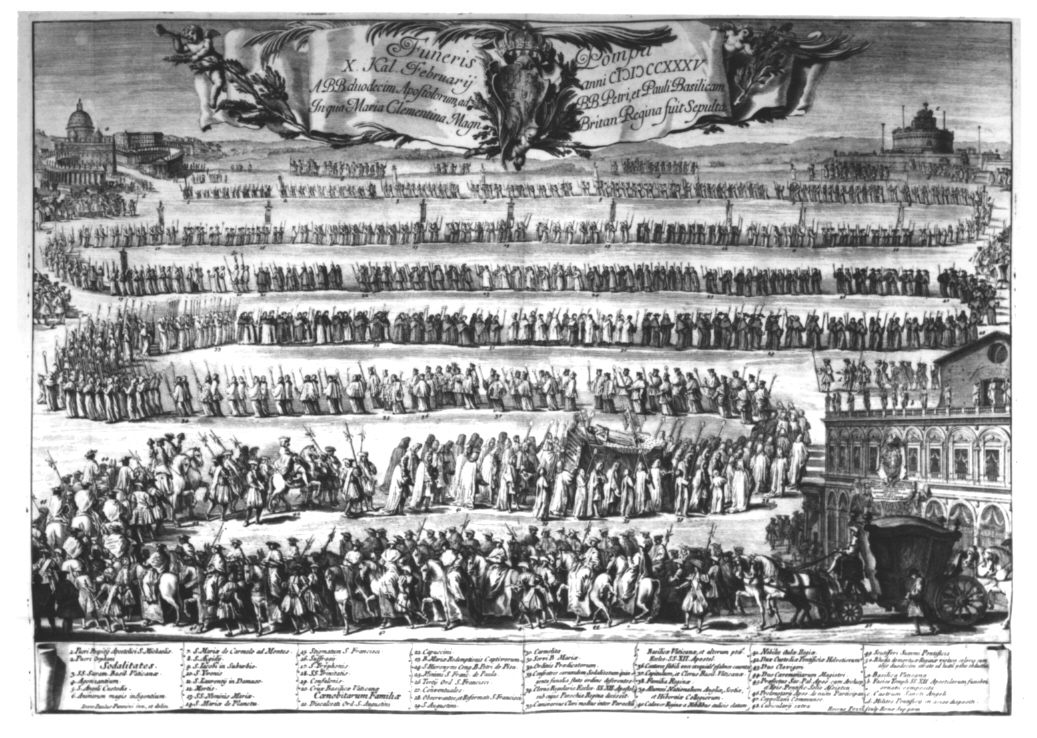
Funeral exequies of Maria Klementyna Sobieska (1701–1735), Jan III’s granddaughter, took place in the basilica of SS. Apostoli in Rome in February 1735. After the service, the royal attire was removed from the dead queen’s body and replaced with a habit and a Dominican veil. The body was then placed in three successive coffins: the first one made of cypress wood; the second one made of lead (attached on it was the coat of arms, the inscription including the titles and the vanitas); the third made of chestnut wood. It was then solemnly transported to the Vatican and laid provisionally in the vault of St Peter’s Basilica, where it was to rest until its transportation to England (which in the end never happened). The said funeral was one of the most magnificent of such services held in contemporary Rome.
It was immortalized in an etching by Roman printmaker Rocco Pozzi (died in ca. 1780), based on an ad vivum (?) drawing by Giovanni-Paolo Pannini (1691 or 1692–1765). The etching depicts the funeral procession moving from SS. Apostoli church towards St Peter’s Basilica visible on the horizon. Seen from above, though not in a bird’s eye view, the procession was marked within the painting size with numbers 1–50, referring to individual groups which are explained by the legend at the bottom. The winding cortège turns six times, thus creating seven parallel lines situated in successively remote backgrounds. Its head, composed of tiny figures of the participants, is approaching St Peter’s Square. The sad cavalcade is closed by the foreground coach covered with a pall, just leaving from in front of the façade of SS. Apostoli church. In the background, alumni of national English, Scottish, and Irish colleges with burning torches in their hands are surrounding the high bier with the queen’s body dressed in royal (not monastic) attire. The upper part of the composition contains a wide, slightly wavy streamer with an inscription separated by a rococo cartouche topped with a crown; the cartouche is composed of five fields with emblems of Poland. The composition is completed with three putti fiddling around in laurel branches.
The print corresponded with Gabbuggiani’s copperplate engraving representing funeral exequies of Maria Klementyna and was likewise included as illustration in the prestigious publication entitled Parentalia Mariae Clementinae Magn. Britan. Franc. Et Hibern. Regin. Jussu Clementis XII Pont. Max., printed in 1736 in Rome by Giovanni Maria Salvioni.
Rocco Pozzi, based on a drawing by Giovanni-Paolo Pannini: Funeral of Maria Klementyna Sobieska, etching, publ. 1736.
We would like to inform that for the purpose of optimisation of content available on our website and its customisation according to your needs, we use information stored by means of cookies on the Users' end devices. You can control cookies by means of your Internet browser settings. Further use of our website without change of the browser settings means that you accept the use of cookies. For more information on cookies used by us and to feel comfortable about this subject, please familiarise yourselves with our Privacy Policy.
✓ I understand